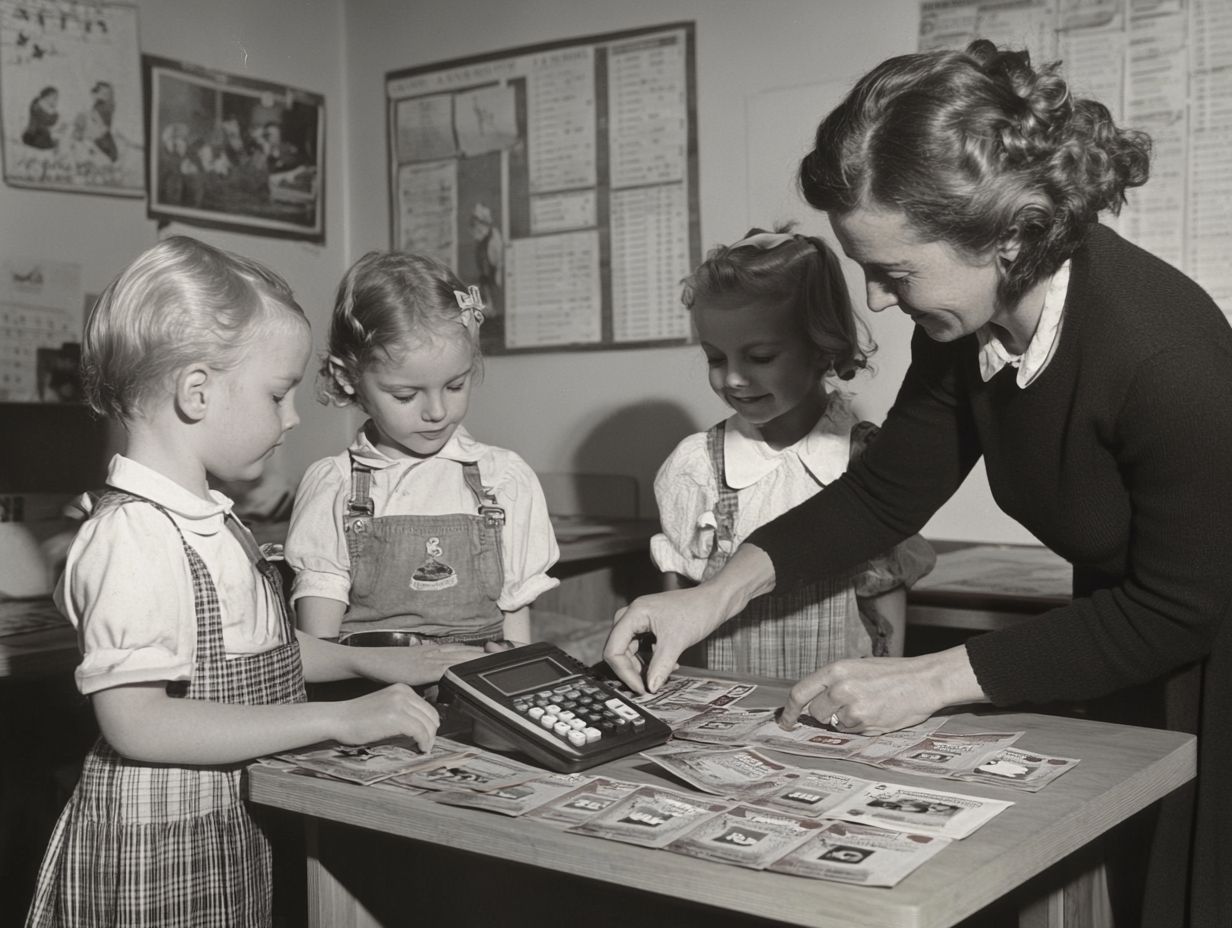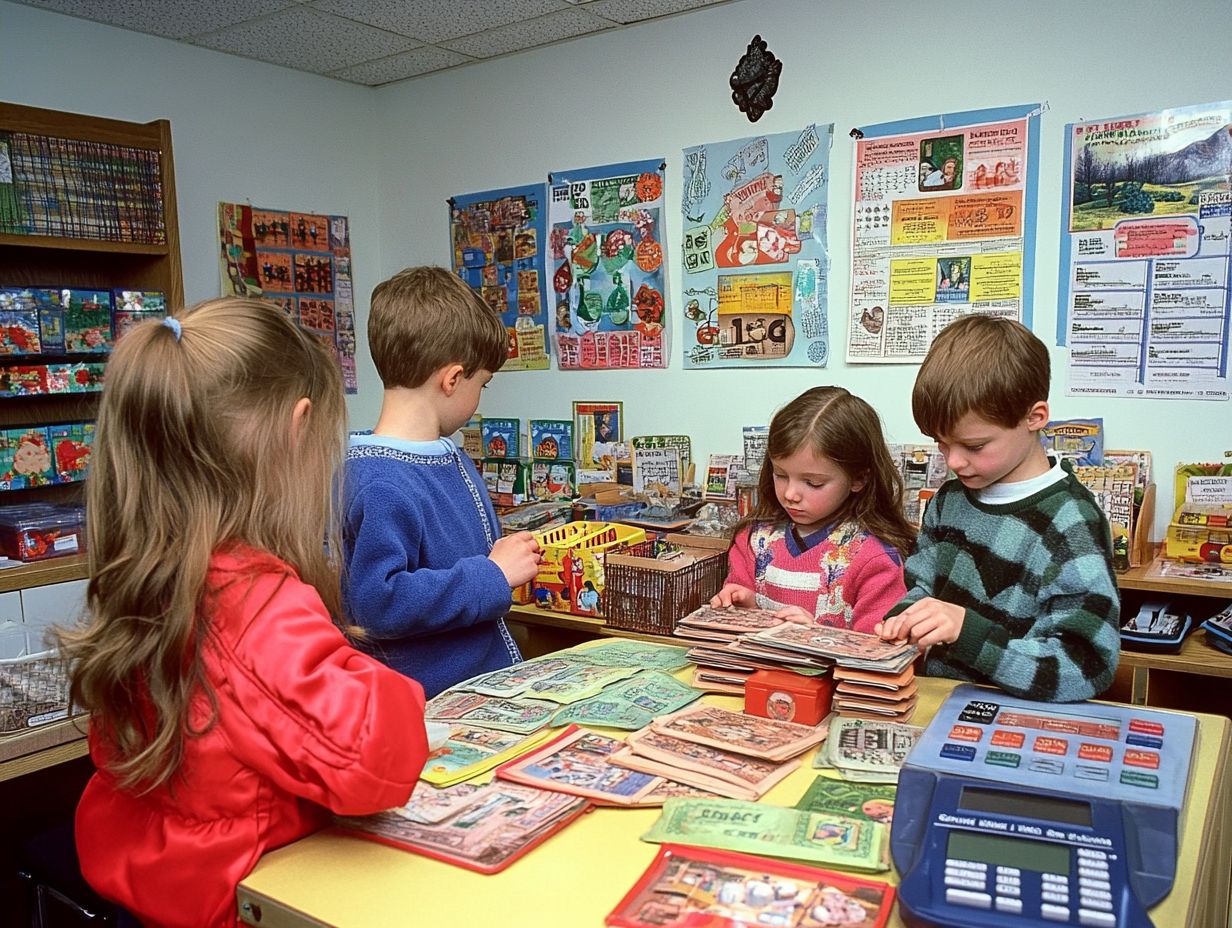Teaching children about money is crucial for their future success and independence. In a world where financial literacy is increasingly vital, grasping money management skills, budgeting, and responsible spending can lay the groundwork for a secure future.
This article examines the appropriate timing for introducing financial concepts, age-appropriate lessons, and practical activities that make learning about money engaging. By exploring topics such as understanding credit and utilizing beneficial resources, it aims to uncover effective methods for enableing the next generation with essential financial knowledge.
Why Teach Kids About Money?

Teaching children about money is crucial for their future financial security, as it provides them with essential skills in money management, budgeting, and saving.
A solid understanding of financial concepts such as needs versus wants, expenses, and income establishes the foundation of financial literacy, enabling children to make informed financial decisions throughout their lives.
Furthermore, fostering sound spending habits and a sense of financial responsibility will assist them in building wealth and achieving financial independence.
Through parental guidance and the implementation of educational resources, we can cultivate economic understanding and enable our children to effectively navigate financial challenges.
The Importance of Financial Literacy
Financial literacy is an essential skill that enables individuals to manage their finances effectively, providing a robust foundation for achieving financial goals and aspirations. This knowledge encompasses critical topics such as budgeting, saving, and comprehending the complexities of investments.
By understanding these concepts, individuals can develop responsible spending habits that ultimately enhance their decision-making abilities.
For instance, effective budgeting enables individuals to monitor their income and expenses, ensuring that their spending aligns with financial priorities. Saving creates a safety net for unforeseen circumstances, while understanding investment opportunities can facilitate wealth accumulation over time.
As a result, financial literacy not only prepares individuals for immediate financial challenges but also equips them with the necessary tools for long-term economic success.
When to Start Teaching Kids About Money
Introducing financial education to children at an early age is essential, as it establishes the foundation for a lifetime of sound financial habits and economic understanding.
Parents and educators should initiate this process by integrating basic money management concepts into age-appropriate lessons that engage children, such as instructing them on the value of coins and the functionality of bank accounts.
By commencing discussions about money at an early age, we can cultivate an environment of financial awareness and responsibility, thereby equipping children for more advanced financial concepts during their teenage years and beyond through structured financial literacy programs.
Age-Appropriate Concepts and Lessons
Age-appropriate lessons in financial literacy should be meticulously tailored to align with a child’s developmental stage, introducing essential concepts of money management in an engaging and relatable manner.
For young children, this may involve simple activities such as counting coins or utilizing play money in a mock store setup, thereby making the abstract concept of currency more tangible.
As children progress in age, particularly between 7 and 10 years, the focus can shift to more sophisticated concepts such as saving for specific goals. At this stage, children can learn to set aside their allowance to purchase a desired toy or video game. Incorporating interactive games that simulate savings and spending during this period can effectively reinforce the principles of budgeting.
For teenagers, aged 13 to 17, discussions can advance to topics such as credit, budgeting, and the fundamentals of investing. These concepts may be introduced through hands-on projects, such as tracking personal expenses or participating in a stock market simulation game.
Each of these age-appropriate lessons contributes to establishing a solid foundation for financial independence and proficient money management.
Basic Money Management Skills for Kids
The foundation of fundamental money management skills for children is centered on the principles of budgeting, saving, and responsible spending. By acquiring the ability to create a monthly budget and distinguish between necessities and desires, children can cultivate essential financial competencies that will serve them throughout their lives.
Encouraging children to establish financial goals and utilize tools such as piggy banks or savings accounts can reinforce the value of money and promote a sense of financial responsibility. These concepts not only foster sound financial habits but also enable children to make informed decisions regarding their personal finances.
Budgeting and Saving

Budgeting and saving are essential components of effective money management and are vital life skills that every child should acquire at an early age.
Understanding how to track income and expenses is a crucial first step in this educational journey. For instance, children can utilize simple spreadsheets or budgeting applications to visually represent their financial inflows and outflows.
This practice not only fosters financial awareness but also emphasizes the importance of prioritizing needs over wants. Establishing a dedicated savings account can promote the habit of reserving funds for future objectives, whether for a desired toy or a larger purchase such as a bicycle.
By implementing these techniques, young individuals can cultivate a robust foundation for realizing their financial aspirations.
Earning and Spending Responsibly
Instructing children on the principles of earning and spending responsibly is essential for fostering financial responsibility and developing prudent spending habits that will serve them well throughout their lives.
One effective approach to enable children to earn their own money is by encouraging them to undertake household chores or small tasks for neighbors. These activities not only impart the value of hard work but also cultivate a sense of accomplishment.
Equally important is the guidance provided on wise spending practices. Encouraging children to save a portion of their earnings can instill positive financial habits for the future. Practical strategies such as creating a budget or discussing the distinction between needs and wants can assist them in making informed decisions.
Additionally, introducing the concept of comparison shopping allows them to assess prices and identify optimal deals, reinforcing the notion that careful research can lead to more informed purchasing choices.
Teaching Kids About Credit and Debt
Comprehending credit and debt constitutes a fundamental aspect of financial literacy that must be prioritized in a child’s education, as these concepts are integral to the management of personal finances.
Understanding Credit Scores and Interest Rates
Understanding credit scores and interest rates constitutes a fundamental aspect of financial literacy, enabling young individuals to make informed financial decisions.
These elements are crucial in determining a person’s borrowing capacity. Various factors, including payment history, credit utilization ratio, length of credit history, and types of credit accounts, all contribute to the overall credit score.
For instance, consistently making timely payments and maintaining low credit card balances can result in a stronger credit score, subsequently providing access to more favorable loan options and reduced interest rates. For example, an individual seeking to purchase a vehicle might qualify for a loan with an interest rate of 3% rather than 7% with a higher credit score, resulting in significant savings over time.
Therefore, comprehending these concepts not only facilitates the process of securing loans but also enables individuals to navigate the financial landscape with greater intelligence.
Practical Ways to Teach Kids About Money
Implementing effective strategies to educate children about money is essential for enhancing their financial literacy and enabling them to navigate financial decisions with confidence.
Games, Activities, and Real-Life Examples

Incorporating games and activities into financial education serves to enhance the learning experience regarding money for children, making it both enjoyable and engaging while promoting financial responsibility.
By utilizing resources such as play money, budgeting simulations, and interactive applications, parents can establish a dynamic learning environment that captures children’s interest. These tools not only encourage children to explore essential financial concepts such as saving, spending, and investing but also assist them in developing effective money management skills.
When children engage in hands-on activities that simulate real-life financial scenarios, they are more likely to retain important information and cultivate a positive attitude towards budgeting and saving. As they navigate these engaging challenges, young learners can appreciate the value of money and build a solid foundation for lifelong financial literacy.
Tools and Resources for Teaching Kids About Money
Employing a diverse array of tools and resources for educating children about money can substantially improve their comprehension of financial literacy and effective money management skills.
Books, Apps, and Other Educational Materials
Numerous books, applications, and educational resources are available that can serve as effective tools for enhancing children’s financial literacy.
Among these resources, acclaimed titles such as “Money Ninja: A Children’s Guide to Saving, Investing, and Spending Smart” are particularly noteworthy, engaging children through relatable storytelling. Applications like “PiggyBot” provide interactive platforms that enable children to track their savings, thereby offering them valuable real-life experience in financial management.
By integrating these resources into lesson plans, educators can establish a dynamic learning environment that not only imparts essential concepts of budgeting and saving but also encourages practical applications in everyday situations.
Furthermore, by introducing these materials at home, parents can facilitate important discussions about money, ultimately contributing to the development of well-informed future consumers.
Frequently Asked Questions
What is the best age to start teaching kids about money?
The best age to start teaching kids about money is around 5-6 years old. This is when children start to understand basic concepts, such as counting and basic math, and can begin to grasp the value of money.
How can I teach my child the value of money?

One way to teach kids about the value of money is to give them a set allowance and encourage them to save a portion of it. You can also involve them in budgeting and decision-making when it comes to spending money on toys or treats.
What are some fun ways to teach kids about money?
There are many fun and creative ways to teach kids about money! You can play games that involve counting and budgeting, create a pretend store for them to “buy” items from, or use play money to practice making purchases and giving change.
How can I help my child develop good money habits?
One way to help your child develop good money habits is to lead by example. Show them the importance of budgeting, saving, and making responsible financial decisions. You can also involve them in age-appropriate financial activities and encourage them to set goals for saving money.
Is it important to teach kids about credit and debt?
Yes, it is important to introduce kids to the concept of credit and debt early on. You can start by explaining the basics and how credit works. As they get older, you can also discuss the potential consequences of taking on debt and the importance of responsible credit use.
How can I make learning about money fun for my child?
You can make learning about money fun for your child by incorporating it into everyday activities. For example, have them help you create a grocery list and stick to a budget while shopping. You can also use money-themed books or videos to make learning more enjoyable.




